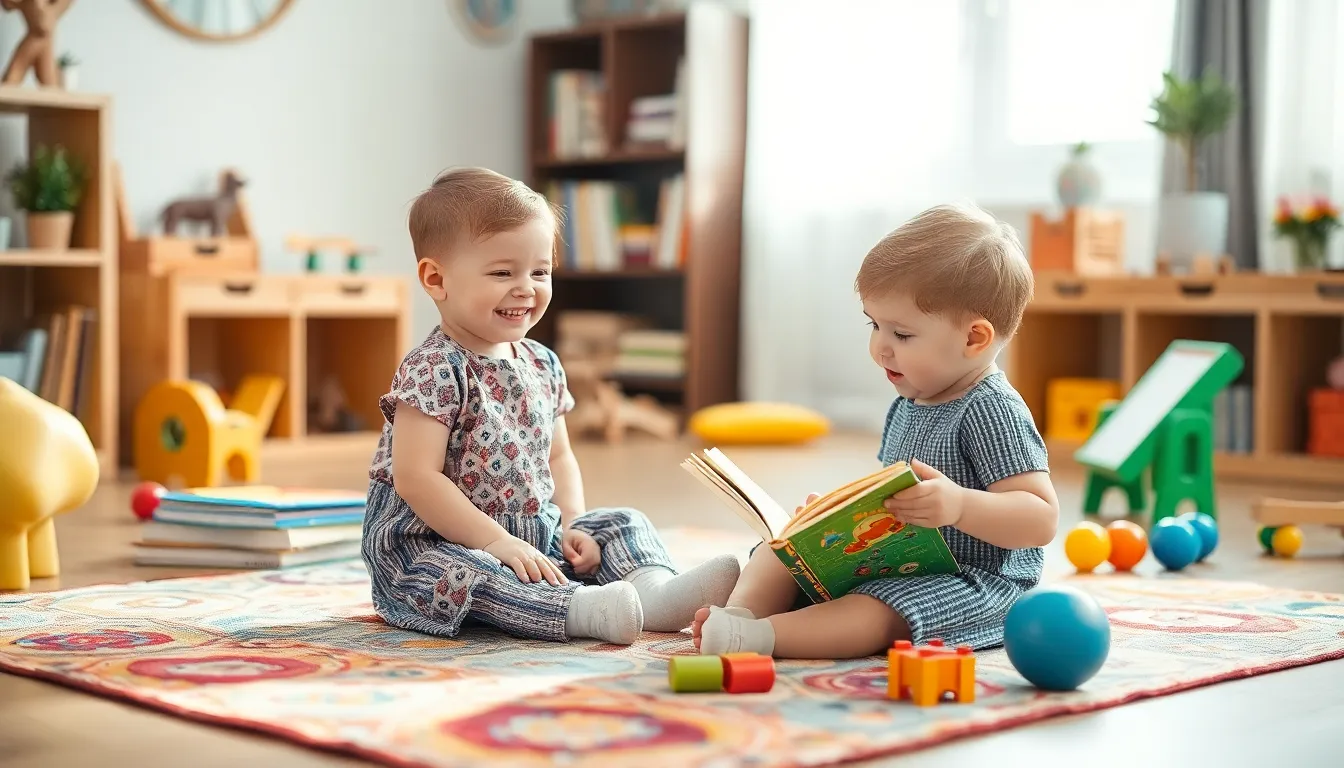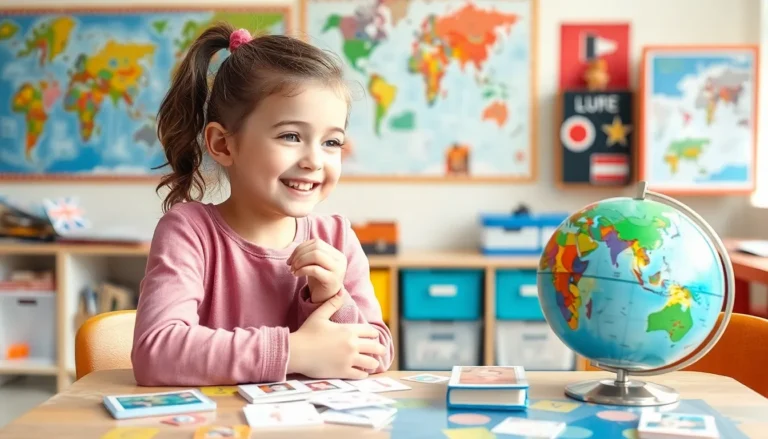From the moment a baby coos or babbles, a fascinating journey begins. Early language development plays a crucial role in shaping a child’s future communication skills, social interactions, and even cognitive abilities. It’s not just about teaching them to say “mama” or “dada”—it’s about unlocking the door to a world of expression and understanding.
Table of Contents
ToggleUnderstanding Early Language Development
Early language development lays the foundation for children’s communication skills and understanding of their surroundings. It plays a critical role in shaping their future interactions and overall cognitive growth.
Importance of Language in Child Development
Language is vital for expressing thoughts and emotions. Communication fosters relationships with caregivers and peers, enhancing social skills. Mastery of language skills promotes literacy, setting the stage for academic success. Research shows that children who develop strong language skills early tend to perform better in school. Language also helps children comprehend and navigate their environment, further supporting cognitive development.
Stages of Early Language Development
The journey of language development begins in infancy. Infants typically start by cooing and babbling, engaging in vocal play by six months. By their first birthday, many children use simple words, often referring to familiar objects or people. Toddlerhood introduces more complex sentence structures, with children combining words into short phrases by age two. As children approach age three, vocabulary expands rapidly, leading to more elaborate conversations. By age four, most children communicate clear ideas and understand basic grammar rules. These stages highlight the dynamic nature of language acquisition throughout early childhood.
Factors Influencing Early Language Development

Several crucial elements shape early language development in children. These factors consist of biological and environmental influences, both of which significantly impact a child’s communication skills.
Biological Factors
Genetics plays a key role in language development. Certain inherited traits can affect a child’s ability to process language and learn sounds. Neurological development also contributes to this process. Brain regions associated with language become activated as children interact with their environment. Hearing capability directly influences language acquisition; children who experience hearing impairments may face challenges in developing communication skills. Additionally, age factors into language milestones, as younger children typically acquire words and phrases more rapidly than older ones.
Environmental Factors
The environment in which a child grows has a profound effect. Exposure to rich language experiences enhances vocabulary growth. Regular conversations with caregivers foster language skills, while reading books together increases comprehension and storytelling abilities. Social interactions with peers also contribute to language development. Frequent engagement with diverse words and phrases within everyday contexts helps children grasp their meanings and usage. Supportive environments, filled with encouragement and praise, further motivate children to experiment with language and develop confidence in their communication abilities.
Strategies to Support Early Language Development
Supporting early language development involves practical strategies that enhance communication skills. Engaging children through various activities encourages their budding language abilities.
Reading to Children
Reading to children establishes a strong language foundation. Choose diverse books that introduce new vocabulary and ideas. Regularly reading aloud exposes kids to different sentence structures and sounds, enriching their understanding. Incorporating questions during reading sessions promotes critical thinking and comprehension. Selecting age-appropriate stories keeps interest high, enabling children to connect with characters and narratives. Creating a routine around reading fosters a love for books, encouraging lifelong learning. Furthermore, expressive reading with varied tones sparks imagination, making the experience interactive and enjoyable.
Encouraging Verbal Interaction
Encouraging verbal interaction significantly boosts children’s language skills. Asking open-ended questions stimulates deeper conversations, allowing children to express thoughts freely. Listening actively to children’s responses validates their efforts, promoting confidence in communication. Providing ample opportunities for conversations during everyday activities builds natural language learning experiences. Incorporating play into verbal interactions fosters creativity and exploration of language. Engaging in role-play or storytelling enhances vocabulary and narrative skills. Celebrating milestones, such as new words or phrases, reinforces achievements, encouraging continued linguistic growth.
Common Challenges in Early Language Development
Early language development can present numerous challenges. Recognizing these obstacles ensures timely intervention and support for children in their language journey.
Delayed Language Development
Delayed language development affects many children. This condition manifests when a child does not meet expected language milestones at their age. Research indicates that approximately 10 to 15 percent of children experience some form of delay. Factors contributing to this delay include limited exposure to language and hearing deficits. Regular assessments are crucial for identifying delays early. Interventions can range from speech therapy to targeted language-rich activities. Parents and caregivers play a vital role by providing engaging conversations and reading opportunities.
Speech Disorders
Speech disorders can significantly impact communication. Types of speech disorders include articulation disorders, fluency disorders, and voice disorders. Articulation disorders involve difficulty pronouncing sounds, affecting about 8 to 9 percent of preschoolers. Fluency disorders, characterized by stuttering, affect roughly 1 percent of children. Voice disorders impact the quality of speech and can stem from physical issues or misuse. Early identification is essential, as effective treatments can improve speech clarity and confidence. Collaboration with speech-language pathologists often leads to successful outcomes, enabling children to communicate with ease.
Early language development is a vital aspect of a child’s growth that shapes their future communication and social skills. By fostering a rich language environment and encouraging interaction, caregivers can significantly enhance a child’s ability to express themselves and connect with others.
Addressing challenges such as delayed language development and speech disorders through timely intervention ensures that every child has the opportunity to thrive. The strategies outlined not only support language acquisition but also build confidence and creativity. Investing in early language development is an investment in a child’s lifelong learning and success.



